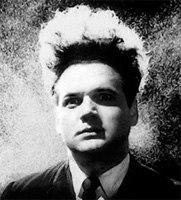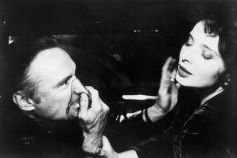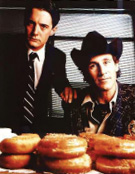home | metro santa cruz index | movies | current reviews | essay

Through A Glass Darkly
A young person's guide to the films of David Lynch
By Richard von Busack
What are Lynch films? Theaters of decay, celebrating the rot and detritus of industrial culture.
Are they melodramas which the outside world keeps pushing in on a recessive character--Henry in Eraserhead, The Elephant Man--or are they "dark and troubling dreams" of innocent women in peril?
Two elements to keep in mind:
The dead-dog rule. Take away the name of something, such as "a dead dog," and it becomes an array of surfaces, fur and shiny wetness. Remove a syllable from a sentence, give someone deafness or obscure a word, and meaning shifts and changes.
And another rule: The "eye of the duck" rule that Lynch explained in the documentary Don't Look at Me (1988). A duck is an array of freakish qualities that don't fit together--an elongated neck; a rounded glossy head, too small for its body; a protuberant hard beak. But the duck's eye--"a jewel," Lynch says--is the focal point which creates a harmonious creature out of these jarring parts. That's how we get a happy floating mallard instead of a monster.
Finding the point of perspective, Lynch says, is the key in all of his films, either the floating romantic ones, wafting on the skies or reflected in the waters, or soaring on the throb of Julee Cruise's voice ... or in the putrefying, violent ones with their demons lurking behind the curtain.
His Filmography
The Short Films of David Lynch
(1967-1995)
Essential viewing. Includes his first work, the Six Men Getting Sick (1967), as well as his recent short filmed on a primitive Lumiere brothers-style camera ("Lumiere")--a less-than-minute-long study for a Lynch melodrama, with a kidnapped girl, a nude prisoner in an alien holding tank. The Grandmother (1970) could really be called the first film to have the wings and claws of a David Lynch film. There is a menaced pale child in a ducky little suit, a father who barks and a mother who has an incestuous need of love, wanting to kiss the boy with that all devouring mouth that Lynch loves and dreads.
POSSIBLE CLUE: The Francis Bacon-style mottling in the painted fountains of vomit in Six Men Getting Sick. Comparing Bacon and Lynch: there's an essay for someone.
Eraserhead (1977)
March 19, 1977: the Filmex at the Plitt Century City Cinemas in Los Angeles. Eraserhead makes its debut; and is considered a failed horror movie by Variety, which accuses Lynch of gorehoundism, of "emulating Herschell Gordon Lewis." My encounter with the film when it goes to the Nu-Art theater in West Los Angeles was sleep teaching. I must have slept through it four times; they played it at midnight and the custom of the time was to tank up on weed and whatever else was going around. Nice, warm theater, ambient noise, and before long ... zzzz. Wake up from the slumber when there was a buzz or howl, or the god-awful wail of the meat-puppet co-star.
At a reasonable hour, the film is a different story: cryptic, deranged, cinema's finest birth-control propaganda movie. And, at heart, a souvenir of a polluted and religious industrial hell-hole. As Lynch told the Philadelphia Inquirer, Philly was "the sickest, most corrupt, decaying city filled with fear I ever set foot in my life. I saw horrible things, horrible, horrible things. I never had an original idea until I came to Philadelphia." Though filmed in L.A., Eraserhead is his tribute to his adopted town.
POSSIBLE CLUE: The Great Piggy Bank Robbery, Bob Clampett's 1946 cartoon, features Daffy Duck meeting a character called Eraserhead. ("I'm gonna rub you out!")
The Elephant Man (1980)
A movie in need of a revival. The story of a famous Victorian sufferer. Lynch scholar David Sterritt suggests this is a commercial remake of Eraserhead. It continuing the inquiries into teratology and the surroundings that create it. Yet today it looks as silvery and as stately as a James Whale film from the 1930s. It's also one of the last stiff-upper-lip films, celebrating that faith that Englishmen can face any horror, no matter how extreme, with dignity and calm ... even the mind-shattering sight of the lamentable Merrick (John Hurt).
POSSIBLE CLUE: Read it as Lynch's most spiritual movie.
Dune (1984) Disowned work for hire, and yet the personality of Lynch is not held down at all in this Panic in the Year 10,191 story. Space movies are at their most dull when every invention has to be explained, and Dune rejoices in the inexplicable--four planets, different classes of human, so much backstory that the floating head of Virginia Madsen has to come out and explain the entire plot (and the cut version has the explanation even longer!). What it boils down to is the Emperor of the Known Universe's labor troubles, and a feud between two powerful clans. The Atreides are handsome and brave. Their enemies are led by the baron Harkonnen, a sodomite who pampers his pimples. The good are beautiful and the evil are ugly, and that's what fiction means, to paraphrase Oscar Wilde.
The epic male chauvinism of Frank Herbert's telephone-book-size epic is translated faithfully. It is at heart the story of a mom-struck messiah (Kyle MacLachlan) getting free of her and the order of nuns she belongs to, through the ordeal of drinking the "water of life" (downing a couple of eau de vies would make this movie go a little smoother). Still: what a suite of "rooms," to use Lynchese for his scenes: the Aztec look of the Churubasco Studios, with a moaning Toltec head in a plaza outside a 3-mile-tall sky scraper.
POSSIBLE CLUE: A swipe from Ed Wynn's scenes in Mary Poppins, Baron Harkonnen (the preposterously happy Kenneth McMillan) becomes so inflated with cackling malice that he floats like a balloon.

Blue Velvet (1986)
"What are you, a detective or a pervert?"
"That's for me to know, and for you to find out."
Lynch's single most important movie is popular because of the flamboyantly Freudian madness of Frank Booth; everybody loves Frank. (In Lumberton's bad part of town, Lincoln Street, Booth is the scariest assassin.) In widescreen, Lynch provides visual and moral contrasts as sharp as the war between the colors red and blue. His world here contains both the "Pussy Heaven" bordello, where the hostesses are on the sour side of 50 and the south side of 300 pounds. It also contains the heavenly aura of a church at night leaking stained-glass light and organ music. Neither image is ironic. Lynch has been called the last romantic filmmaker. And here he proves he's the last man left who knows how to correctly stage a perfect kiss in widescreen.
A huge influence on Tarantino (et al., and there sure is a hell of a lot of al.) in the rhythmless dances and volcanic profanity. Of course, QT would have made Lumberton's Sin City a black ghetto. Imagine Samuel Jackson howling "Don't look at me!"
Of its myriad shocks, the one that was worst in its day was Blue Velvet's suggestion that there were some women, such as the lusciously deranged Dorothy Vallens (Isabella Rossellini), who might enjoy being sexually roughed up. The 1990s unleashed blogs, confessionals, memoirs and one-woman shows exploring the idea of consensual S&M. But to get an idea of how horrifically novel the idea was, get a look at the extra on the Blue Velvet DVD: Roger Ebert's bloviation about how Rossellini's nude scenes were "cruelly unfair." This gallantry that might have occurred to the critic, back when he was writing scripts that devised new ways to get Kitten Natividad's kit off.
POSSIBLE CLUE: Mary Poppins again: the bluebird with which she sings a duet seems to be a cousin of the robin in the last scene.
Wild at Heart (1990)
In my mind, his weakest film, the most commercial, the most mannered, the one meant to be almost as slick as a drive-in feature.
POSSIBLE CLUE: It's all pretty straightforward, actually.

Twin Peaks/Twin Peaks: Fire Walk With Me (1990-1; 1992)
While there are moments outside of nature in his first film, this is the serial in which a fascination with the demonic nature of evil, of the splitting of identity begins; Lynch writes in Catching the Big Fish that Frank Silva, a set-dresser, had his reflection accidentally caught in a mirror: thus his casting as the demon in charge, "BOB." The series coins the term "garmonbozia" (pain and suffering), the currency of the demon realm.
POSSIBLE CLUE: The "tailored dress" dancer introduced by the deaf FBI agent (Lynch) in Fire Walk With Me suggests that choreography is always coded in Lynch's film, all the way back to the Radiator Lady's "flamenco placenta dance," in Lynch scholar Kenneth C. Kaleta's phrase.
Lost Highway (1997)
Lynch offers a key in Catching the Big Fish: O. J. Simpson's insistence on his innocence.
POSSIBLE CLUE: The Mystery Man (Robert Blake) seems to be dressed like Roy Orbison. Is Orbison's music some sort of interdimensional porthole-opener? The Club Silencio experience later on would seem to suggest, "Maybe."
The Straight Story (1999)
"I fell in love with the emotion of the script," Lynch says in Catching the Big Fish. An easy film to watch and decipher, and to understand Lynch's love of silence and open space; thanks to Richard Farnsworth, it's easy to translate the unsaid.
POSSIBLE CLUE: With all of the current cinematic probing of World War II, it's strange that this film about a still-haunted vet doesn't get more interpretation.
Mulholland Dr. (2001)
Lynch's reflection of Billy Wilder's Sunset Boulevard ... and knowing that helps explain how a movie could be narrated by a corpse. All the essays on it are like a ring of keys; some fit; some don't, some are for other doors than this one. A still-insoluble mystery despite these intrepid theorists. I feel there's an indictment in here of the audience's own taste for recorded images bearing "garmonbozia," pain and suffering. On a recent viewing, I was struck by the late Ann Miller's scene in which she patronizingly pats the hand of the new girl in town who talks about how she got there after winning a jitterbug competition. How many times do you suppose in real life Miller heard stories like that when she was a star at MGM?
POSSIBLE CLUES: "Winkies" are a race of people in The Wizard of Oz. The restaurant itself still stands: Cesar's, 1016 W. El Segundo, Gardena.
Send a letter to the editor about this story.
|
|
|
|
|
|